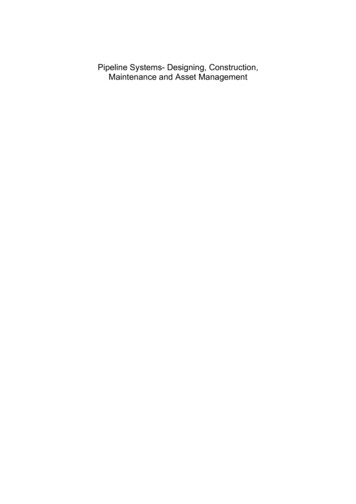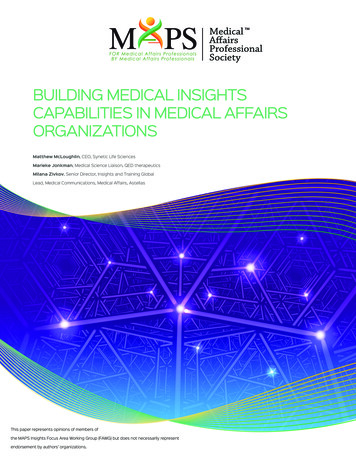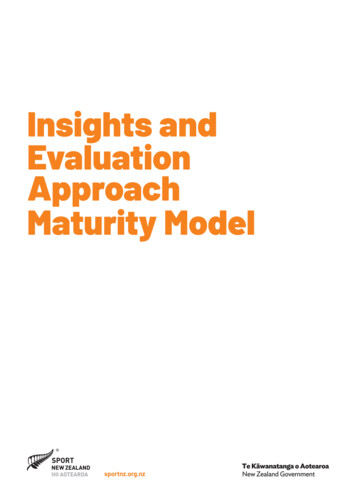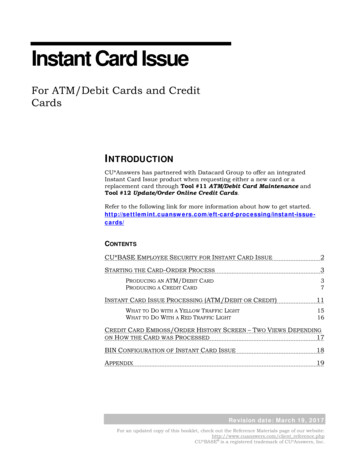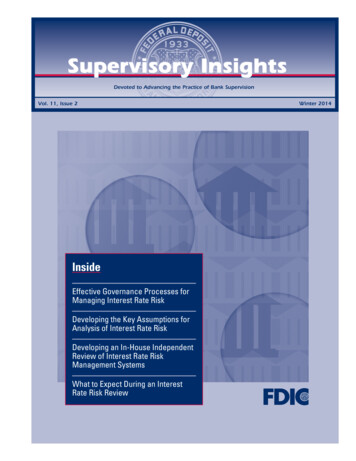
Transcription
Devoted to Advancing the Practice of Bank SupervisionVol. 11, Issue 2 InsideEffective Governance Processes forManaging Interest Rate RiskDeveloping the Key Assumptions forAnalysis of Interest Rate RiskDeveloping an In-House IndependentReview of Interest Rate RiskManagement SystemsWhat to Expect During an InterestRate Risk ReviewWinter 2014
Supervisory InsightsSupervisory Insights is publishedby the Division of Risk ManagementSupervision of the Federal DepositInsurance Corporation to promotesound principles and practices forbank supervision.Martin J. GruenbergChairman, FDICDoreen R. EberleyDirector, Division of Risk ManagementSupervisionJournal Executive BoardDivision of Risk ManagementSupervisionGeorge E. French, Deputy Director andExecutive EditorJames C. Watkins, Senior DeputyDirectorRobert L. Burns, Deputy DirectorMelinda West, Deputy DirectorDivision of Depositor and ConsumerProtectionSylvia H. Plunkett, Senior Deputy DirectorJonathan N. Miller, Deputy DirectorRegional DirectorsMichael J. Dean, Acting RegionalDirector, Atlanta RegionKristie K. Elmquist, Dallas RegionStan R. Ivie, San Francisco RegionJames D. LaPierre, Kansas City RegionM. Anthony Lowe, Chicago RegionJohn F. Vogel, New York RegionJournal StaffKim E. LowryManaging EditorDaniel P. BergmanFinancial WriterJeffrey A. FahrmannFinancial WriterSupervisory Insights is availableon-line by visiting the FDIC’s Web site atwww.fdic.gov. To provide comments orsuggestions for future articles, requestpermission to reprint individual articles,or request print copies, send an e-mailto SupervisoryJournal@fdic.gov.The views expressed in Supervisory Insights arethose of the authors and do not necessarily reflectofficial positions of the Federal Deposit InsuranceCorporation. In particular, articles should not beconstrued as definitive regulatory or supervisoryguidance. Some of the information used in thepreparation of this publication was obtained frompublicly available sources that are consideredreliable. However, the use of this information doesnot constitute an endorsement of its accuracy bythe Federal Deposit Insurance Corporation.
Issue at a GlanceVolume 11, Issue 2 Winter 2014Letter from the Director 2ArticlesEffective Governance Processes for Managing Interest Rate Risk3The foundation of an effective interest rate risk (IRR) management process is the establishment of board-approvedpolicies that measure, monitor, and control IRR. As discussed in this article, a successful governance framework isgrounded in an informed and involved board of directors that provides senior management with clear policy guidance,sufficient internal resources, and risk mitigation strategies to guide an institution’s IRR position well in advance ofmarket shifts.Developing the Key Assumptions for Analysis of Interest Rate Risk11Effective IRR measurement and monitoring requires accurate information; therefore, bank management should developassumptions that are readily understood, well supported, and updated periodically. This article describes the processfor developing key assumptions necessary to analyze interest rate sensitivity in the current environment.Developing an In-House Independent Review of Interest Rate Risk Management Systems21An annual independent review of its IRR measurement system is an important part of any bank’s internal controlframework. The scope and formality of such a review should be appropriate for the size and complexity of the bank.This article describes common-sense approaches that non-complex institutions may use to effectively and economicallyperform an IRR independent review in-house.What to Expect During an Interest Rate Risk Review27This article is intended to help bankers prepare for regulatory reviews of IRR by describing what examiners focus on,supervisory expectations with respect to IRR, and communication with the FDIC during an examination. Resources forbankers regarding IRR also are provided.Regular FeaturesRegulatory and Supervisory Roundup 33This feature provides an overview of recently released regulations and supervisory guidance.Supervisory Insights Winter 20141
Letter from the DirectorThis edition of SupervisoryInsights presents an examiner’sperspective on one of the mostimportant issues facing communitybanks—managing interest rate risk(IRR). This edition features articlesauthored by FDIC field examiners thatspecialize in IRR reviews at community institutions. We believe thesearticles can help your bank enhanceits IRR management processes and bebetter prepared for a period of higherand more volatile interest rates.Effective governance over IRR is acritical component of a bank’s internal control framework. This includesstrong asset-liability managementpolicies, reasonable investmentand exposure limits, assignment ofaccountability for risk measurementand controls, and appropriate management information systems that helpinform strategic decisions of seniormanagement and the board of directors. “Effective Governance Processesfor Managing Interest Rate Risk”discusses supervisory expectations fora community bank’s IRR governanceprocess and presents ideas for mitigating on- and off-balance sheet risk.The usefulness of an IRR measurement system depends on the reasonableness of the assumptions that areused as inputs. “Developing the KeyAssumptions for Analysis of InterestRate Risk” discusses approaches thatbank staff can use to arrive at reasonable assumptions for use as inputs tothe IRR measurement system.ing an In-House Independent Reviewof Interest Rate Risk ManagementSystems,” we explore expectationsfor independent testing as set forth inthe 1996 interagency directive on IRRmanagement and present a conceptfor performing this function effectivelywith capable bank employees.And finally, this edition provides anexaminer’s perspective on how bankers can better prepare for their nextIRR examination. “What to ExpectDuring an Interest Rate Risk Review”explains how examiners plan reviewsand provides insights on communicating with the examination team regarding IRR findings.We hope that you find this editiontimely and useful as your institution works to refine and strengthenits internal policies and systems formanaging rate sensitivity. We welcomeyour feedback on the articles as wellas any topic suggestions for futureissues. Please e-mail your commentsand suggestions toSupervisoryJournal@fdic.gov.Doreen R. EberleyDirectorDivision of Risk ManagementSupervisionBankers inquire about supervisoryexpectations for independent testingand, in particular, who, when, andwhat should be tested. In “Develop-2Supervisory Insights Winter 2014
Effective Governance Processes forManaging Interest Rate RiskManaging interest rate risk(IRR) is one of the mostimportant jobs of a banker.IRR can be a technical subject,but it deals with some of the mostsignificant strategic and operationalquestions that banks face. When theeconomy or interest rates shift direction, how will that affect the bank’sdeposit base, loan customers, andinvestments? Will revenue growthkeep pace with rising deposit costs?Will there be sufficient deposit funding to meet increasing loan demand,or will potentially depreciated securities need to be sold for liquidity? Mostimportantly, does the bank need tochange its strategy now to be betterprepared for the future? While technical experts and IRR software canhelp answer such questions, seniormanagement and the board of directors need to be actively engaged inIRR oversight to ensure that key strategic issues are carefully consideredand addressed on a regular basis.In the years since the financialcrisis, some banks have extendedtheir asset maturities to generateincome in response to low marketinterest rates and a challengingearnings environment. As a result,these institutions’ earnings, equitycapital, and liquidity could beadversely affected by a sustained andsubstantial increase in interest rates.Managing IRR is a central aspectof prudent banking, and in recentyears the FDIC has re-emphasizedthe importance of effective poli-cies, strong internal monitoring andcontrol procedures, and appropriaterisk mitigation strategies to appropriately manage rate sensitivity.1 Goodplanning now can help minimize thepotential for negative impacts.This article highlights the elementsof a successful IRR managementprocess through a discussion of supervisory expectations and observedpractices at well-rated institutions. Anoverview of risk mitigation strategiesis presented to illustrate that IRR canbe appropriately managed throughvarious prudential methods.Governance and the Boardof DirectorsThe 1996 Joint Agency Policy Statement on Interest Rate Risk (“the1996 Policy Statement”) and the2010 Advisory on Interest Rate RiskManagement (“the 2010 Advisory”)2state that the board of directors isultimately responsible for the degreeof IRR taken by an institution andshould understand and monitor exposures that may potentially affect theinstitution’s financial condition. Thisdoes not mean that directors needto be well versed in the technicalaspects of IRR mechanics and modeling, but a basic understanding of IRRcommensurate with the institution’sactivities is essential. Frequently,the recorded minutes of board andasset-liability management committeeManaging Sensitivity to Market Risk in a Challenging Interest Rate Environment, FDIC Financial Institution LetterFIL-46-2013, October 8, 2013, 046.html.1Joint Agency Policy Statement on Interest Rate Risk, FDIC, Board of Governors of the Federal Reserve Board,and the Office of the Comptroller of the Currency, May 14, 1996, 0.html and the Advisory on Interest Rate Risk Management, FFIEC, January 7, 2010, ry Insights Winter 20143
Effective Governance Processes for Managing IRRcontinued from pg. 3(ALCO) meetings at well-rated institutions include director comments orquestions on matters that go beyondthe current and prospective interestrate environment and include pricing strategies, product mix, and mostnotably, the rationale behind policydeviations and underlying causes ofchanges in the bank’s risk profile.IRR management from a director’sperspective is not about projecting how and when rates will change;instead, it is about understanding howthe bank will be affected by a range ofoutcomes and ensuring that assumedrisks are reasonable and properlycompensated for. Such notations inthe minutes portray an engaged andinformed directorate that ensures itsstrategies are executed within established policy. Senior management’sprimary objectives should be administering board-approved policies, including day-to-day oversight of risk taking;maintaining an effective IRR measurement system; and collecting and interpreting meaningful data to inform thedirectorate of exposure levels.A clearly articulated asset-liabilitymanagement policy with appropriate IRR guidelines ensures that IRRexposure is measured, reported, andmaintained within tolerable parameters. The policy should establish clearlines of authority and responsibility;define allowable products, services,and activities; and include risk mitigation strategies. To prudently controlrate sensitivity, written policies shouldrequire regular IRR measurement3 andmeaningful risk limits.According to the 1996 Policy Statement, senior management and the board or board committee should reviewreports on the bank’s IRR profile at least quarterly. More frequent reporting is often warranted.34Supervisory Insights Winter 2014
Establishing Policy Limits: Setting the Board’s Tolerance for IRRExaminers are sometimes asked, “What limits arereasonable for changes in net interest income (NII) oreconomic value of equity (EVE)?” Rules of thumb existin the industry, but each bank is unique, and it is difficultto apply a uniform set of limits. In establishing limits, theboard and senior management should focus on the potential impact of interest rate scenarios on net income andEVE, taking into consideration the effect on the value ofthe investment portfolio, the ability of the bank’s existingborrowers to repay their loans, and depositor behavior.The bank’s financial condition and risk profile should bethe guiding factors that influence the level of tolerance theboard mandates in setting limits. Limits should not be solow as to frequently require exception approval or refinement, and they should not be set so high as to allow for anunacceptable level of IRR. If established limits have beenor are about to be breached, management should takemitigating steps to ensure that IRR is maintained withinboard-approved limits.It is important for directors to consider what the limitis based on (for example, a 20 percent change in NIIis different from a 20 percent change in ROAA). In thegraph shown below, we can observe the impact to netSupervisory Insights income (vertical axis) if net interest income (horizontal axis) were to decline by as much as 20 percent. Inthis case, pre-tax ROAA would decline more than 60percent through what may have been considered only amoderate and acceptable degree of NII exposure at 20percent. In evaluating the appropriateness of 20 percentas a policy limit, the bank’s board should consider howit would address the potential for a pronounced declinein net income and weigh the impact and feasibility ofthose actions against the impact of lower policy limitsFor example, one approach may be to adjust assetgrowth expectations or raise additional capital givenlower forecast earnings. Another approach might be toassess whether reductions could be made to overheadexpenses. If these actions would not be feasible, orwould be feasible but not desirable in light of the bank’soverall strategic plan, then the board should considertightening the policy limits, which may require formal riskmitigation strategies (e.g., initiating changes in the maturity and re-pricing characteristics of assets or liabilities)as discussed in further detail later in this article. Thisexample highlights the benefit of expanding policy limitconsiderations into a broader financial context.Winter 20145
Effective Governance Processes for Managing IRRcontinued from pg. 5The Role of the ALCOMost financial institutions form anALCO to coordinate balance sheetstrategies, manage liquidity, andmonitor IRR exposures. The 2010Advisory describes an optimal ALCOstructure, which includes representation from major operational functions (e.g., lending, deposit gathering,investing). The advantage of thisstructure is that each member hasan extensive knowledge of product,market, and competitive dynamics inrelation to IRR. Members are typicallysenior or mid-level managers4 whocan convene quickly during evolvingor challenging market environmentsto evaluate, analyze, and recommendmitigating action to the board.In addition to asset-liability management oversight, one importantfunction the ALCO can fulfill is theformulation and periodic reviewof the key assumptions5 the bankuses when analyzing its exposure tochanges in interest rates. Examiners have observed instances wherethe assumptions are formulated by amember of management, commonly aChief Financial Officer (CFO), and arepresented for review and approval bythe ALCO. This process is acceptableand can achieve desired results. TheALCO sometimes plays a more activerole by providing and reviewing theunderlying information and supportingrationale as the basis for assumptionformulation. ALCO members at wellrated institutions are readily familiarwith deposit and loan pricing andcustomer behavior in the bank’s localmarket, which provides the foundationfor the critical assumptions requiringsound judgment, such as non-maturitydeposit sensitivity and loan prepayment activity. This is not to say, forexample, that an ALCO member fromthe lending function will know exacthistorical prepayment metrics on residential mortgages, but the membershould have sufficient experience to beable to reasonably question an assumption under consideration.Internal Controls andIndependent ReviewAs with any well-governed bankingfunction, an adequate system of internal controls promotes the integrity ofthe IRR management process. Clearlines of responsibility and authorityshould be communicated and exercised to ensure consistent monitoring, transparent reporting, and dataintegrity. For institutions that conductin-house analysis with purchasedsoftware, strong controls over the IRRmeasurement process are importantto ensure the accuracy and integrityof reports presented to the boardand senior management. Institutionswith strong controls generally have,at minimum, software access restrictions, data and assumption inputreview procedures, board reports thatinclude changes to assumptions, andidentified staff to serve in a backuprole when needed. Backup personnelExaminers also have observed ALCO membership that includes directors, which provides the board with practical insight into the bank’s risk-taking practices and mitigation strategies.4The 1996 Policy Statement recommends, as part of the independent review, the identification of critical assumptions, an analysis of the assumption process, and an assessment of the impact of chosen assumptions. However,fulfilling this requirement should not preclude the ALCO from conducting periodic reviews, which can reasonablyassure the model generates exposures based on current and relevant assumptions. The 2010 Advisory statesthat proper measurement of IRR requires regularly assessing the reasonableness of assumptions that underlie aninstitution’s IRR exposure estimates. At well-rated institutions, examiners have generally observed that assumption reviews are conducted quarterly before each model run.56Supervisory Insights Winter 2014
should have a basic understandingof IRR including the bank’s policiesand limits, and the ability to use thebank’s particular IRR measurementtools so as to ensure IRR measurement and reporting processescontinue without interruption.The 1996 Policy Statement statesthat banks should conduct an independent review of IRR measurement and control systems along withan annual report to the board thatsummarizes its findings. The boardor ALCO should consider two criticalquestions when discussing independent review findings:1. Does the IRR managementprocess function according topolicy guidelines and prudentrisk management standards?2. Does the IRR measurementsystem reasonably estimateexposures to earnings andcapital based on a logical andsupported set of assumptions?The 1996 Policy Statement also statesthat the scope and formality of anindependent review should be scaledto the complexity of a bank’s activities. Additional perspectives regardingthe independent review process arepresented in “Developing an In-HouseIndependent Review of Interest RateRisk Management Systems” in thisedition of Supervisory Insights.A more advanced facet of the IRRindependent review involves methodological and mathematical testingof vendor-designed IRR models. TheFDIC does not require state nonmember institutions6 to conduct this typeof test, as vendors typically engagea credible third party to validate theintegrity and reliability of their modeling software. Most model vendorshave a sufficiently large client baseto justify the expense of a third-partyvalidation; therefore, it should bereadily available at the client institution’s request. If not, the board shouldseek other alternatives to validatethe model or reconsider whether thevendor is suitable for its institution.Although most community banksare not required to validate purchasedIRR software, bank management isresponsible for ensuring that the keyassumptions entered into the software are reasonable, forward-looking,and appropriate to the bank’s operations. For example, in one case, bankmanagement observed that its IRRsoftware was forecasting interestexpense from non-maturity depositsin a rising-rate environment at a levelthat was materially lower than thebank’s prior experience. Upon recognition of this difference, bank management determined that deposit pricinghad increased at a greater rate thanprojected due to its decision to matcha competitor’s aggressive marketing campaign to attract new depositors when short-term rates began toincrease. Based on the likelihood ofthe competitor continuing the marketing strategy, the bank altered itsnon-maturity deposit rate sensitivityassumptions to better reflect its planto retain valuable core depositors.According to the 2010 Advisory, large and complex institutions may need to conduct in-depth analysis of amodel’s underlying mathematics. Such analysis could take the form of constructing an identical model to testassumptions and outcomes or using an existing, well-validated “benchmark” model, which is typically a lesscostly alternative. Underpinning methodologies in a benchmark model should be closely aligned to those of themodel being validated.6Supervisory Insights Winter 20147
Effective Governance Processes for Managing IRRcontinued from pg. 7Risk Mitigation StrategiesRisk mitigation is an ongoing processto maintain exposures within boardapproved limits to ensure that earnings and capital are sufficient to allowthe bank to withstand adverse interest rate changes. There are a rangeof strategies available should currentexposures be outside comfort levels.Risk mitigation can be as simple asreducing the maturities of futurepurchases of investment securities orextending the duration of liabilities.Well-rated institutions use severalmethods to reduce IRR exposure,including repositioning the balancesheet and hedging. Strong capitallevels or a new capital offering alsocan be a very effective tool for mitigating outsized IRR exposure.The most common risk mitigation strategy is slowly repositioningthe balance sheet over time to moreconsistently align an institution’s overall re-pricing, maturity, and durationprofile.7 When prudently conducted,this approach can help provide a“natural hedge,” whereby an institution that was previously mismatchedwith respect to cash-flow timing orvaluation returns to a more neutralrate sensitivity position. For example,an institution exposed to rising interest rates may need to shorten theduration of assets or extend the duration of liabilities.Before engaging in a balance sheetrepositioning program, institutionsshould analyze the impact on prospective earnings and capital. Generally,the rapid sale of illiquid long-durationsecurities could result in significantlosses and may not be an optimalmethod to reduce risk. When banksfind they possess a higher level of IRRthan desired, an appropriate actionmay be to purchase shorter-dated securities as funding becomes available orincrease the duration of funding.Reducing extension risk in thebond portfolio often involves accepting a lower level of current earnings.Accepting additional risk is typicallyrewarded through a higher return, andIRR is no different in this context.Therefore, some level of IRR can bebeneficial, in moderation. However,banks that are working to reduce theirIRR exposure will also likely see areduction in their interest income asa result. The FDIC strongly supportsbanks’ efforts to control outsizedexposure to interest rate volatilityand will not criticize an institutionfor temporary adverse consequencesto earnings resulting from a prudentrebalancing strategy.A secondary, though more complex,IRR mitigation technique is offbalance sheet hedging. Hedging strategies for IRR typically involve theuse of derivative instruments (e.g.,forwards, swaps, caps, floors, swaptions, and collars)8 and can be effective in curtailing undue IRR if usedin a safe and sound manner. Asdiscussed in the 2010 Advisory, theprimary caveat to consider beforeentering into a derivatives-based hedging strategy is determining whetherthe board and senior management candevelop an appropriate understanding of the proposed hedging strategyDuration is a measure of a financial instrument’s value sensitivity to changes in interest rates. Variations of thisapproach are common to the measurement of EVE in many IRR models.7As described in the 2010 Advisory, hedging with derivative instruments to mitigate IRR may be appropriate forinstitutions with the requisite knowledge and expertise, as it is a potentially complex activity that can have unintended consequences, including compounding losses.88Supervisory Insights Winter 2014
and consider its relevant risks andbenefits based on a comprehensive,reliable analysis. If derivatives hedging is determined to be an appropriate tool for a given institution, theboard and senior management shoulddevelop a thorough set of policies andprocedures covering allowable derivatives contracts, risk and maximumloss limitations in terms of capital,9pre-purchase analysis (includingmodeling) and ongoing monitoringprocedures, authorized transactionalparties, and accounting standards.10Importantly, hedging with derivativesinvolves a new set of IRR measurement considerations before and afterentering into such a contract, as wellas assumptions that would requiresufficient modeling capabilities. Asa general matter, community banksshould carefully consider their abilityto identify and manage the associatedrisks before embarking on a derivatives hedging program.Consequences of UnexpectedMarket Volatility on IRRSensitivityImplementing the elements of astrong IRR governance and riskmanagement framework enablesbanks to effectively manage exposures and prepare their business forthe future. Nonetheless, even whenrisk is well managed, an institutioncould be negatively impacted by unexpected interest rate volatility or otheradverse circumstances.An institution that has extendedthe duration of its fixed-rate assetsto generate additional income, forexample, may experience a negativeimpact to earnings in a higher-interestrate environment as funding costsincrease. While a strong retail depositbase can generally help mitigatethe impact of such a situation, it isimportant to recognize that depositorsmay be more aggressive in seekinghigher-yielding products than previous experience. Of particular note,traditionally stable deposits couldbehave with greater rate sensitivity as a result of structural, technological, and preferential changes thatwere not present the last time ratesincreased after a sustained low-rateenvironment. Furthermore, to theextent an institution has experienced significant deposit growth overthe last several years, some depositbalances may be withdrawn from theinstitution altogether and need to bereplaced with higher-cost deposits orwholesale funding.Institutions that have lengthenedthe duration of their investmentportfolios could experience liquidityconstraints if rapidly rising interestrates cause significant depreciationin the value of those securities. Forexample, liquidity could be severelyconstrained if an institution relies onmarketable securities as a primary orsecondary source of funding. Moreover, existing secured borrowings mayrequire a pledge of additional collateral to address the reduction in thesecurities’ value. An institution couldlikely borrow against unencumbereddepreciated securities at an increasedRisk limitations commonly include, at a minimum, position limits, maturity parameters and counterparty creditguidelines. Counterparty credit guidance becomes more critical for those institutions with over-the-countercontracts given the increased credit risk associated with these instruments.9Accounting standards for derivatives and hedging are set forth in Accounting Standards CodificationTopic 815 – “Derivatives and Hedging.”10Supervisory Insights Winter 20149
Effective Governance Processes for Managing IRRcontinued from pg. 9margin, but only if lenders are willingto extend credit on reasonable terms.This liquidity stress could accelerateif deposit balances were to leave theinstitution altogether or creditors wereto reduce or eliminate lines of credit.While regulatory capital measures(for Prompt Corrective Actionpurposes) for most communitybanks will generally be unaffectedby securities depreciation,11 equitycapital under U.S. generally acceptedaccounting principles (GAAP) canbe compromised. Low or negativeequity capital can produce negativeperceptions of an institution’s financial strength in the eyes of depositors, shareholders, correspondents,and the general public, which couldultimately affect the bank in manyareas. If significant depreciationin securities portfolios diminishedequity capital to low or negativelevels, correspondents and othercounterparties could resist requestsfor credit or require onerous terms.Furthermore, depositors, depositlisting services, and deposit brokerswould need to decide how the bank’sGAAP equity position should affecttheir willingness to continue placingdeposits. Accordingly, contingencyfunding plans should fully and realistically address the potential forreduced borrowing capacity that maybe caused by depreciation in longduration securities and present strategies which ensure prudent levels ofliquidity. To avoid the consequencesof rising interest rates on long-duration securities portfolios, it may beadvisable for certain institutions torebalance their holdings to a moreappropriate position before rate volatility occurs.Banks should understand these andother implications when establishingtheir desired level of IRR and haveplans for dealing with unexpectedmarket volatility and funding issuesthat can arise.ConclusionAn effective governance processfor IRR is a fundamental aspect of astrong risk management framework.A board and senior management teamthat administer effective policies andare well informed can better positiontheir bank to sustain profitability andpreserve capital a
Director, Atlanta Region Kristie K. Elmquist, Dallas Region Stan R. Ivie, San Francisco Region James D. LaPierre, Kansas City Region M. Anthony Lowe, Chicago Region John F. Vogel, New York Region Journal Staff Kim E. Lowry Managing Editor Daniel P. Bergman Financial Writer Jeffrey A. Fahrmann Financial Writer Supervisory Insights is available

